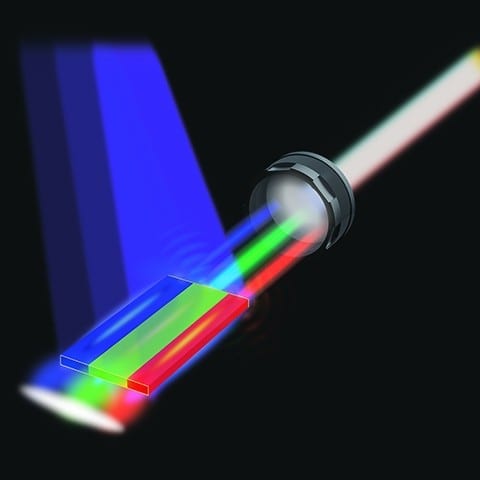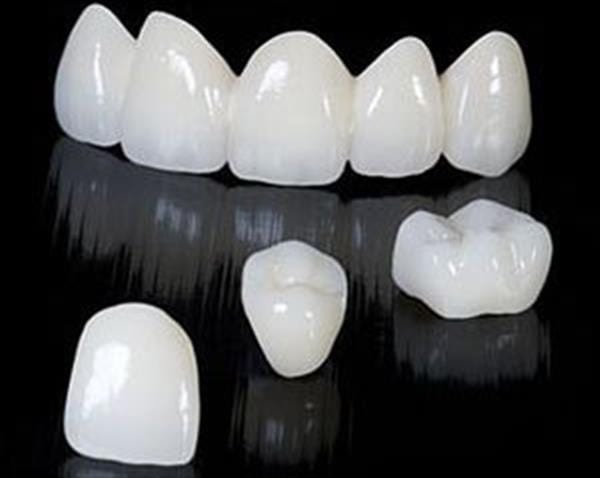
More luminous and energy efficient than LEDs, white lasers look to be the future in lighting and Li-Fi, or light-based wireless communication
While lasers were invented in 1960 and are commonly used in many applications, one characteristic of the technology has proven unattainable. No one has been able to create a laser that beams white light.
Researchers at Arizona State University have solved the puzzle. They have proven that semiconductor lasers are capable of emitting over the full visible color spectrum, which is necessary to produce a white laser.
The researchers have created a novel nanosheet — a thin layer of semiconductor that measures roughly one-fifth of the thickness of human hair in size with a thickness that is roughly one-thousandth of the thickness of human hair — with three parallel segments, each supporting laser action in one of three elementary colors. The device is capable of lasing in any visible color, completely tunable from red, green to blue, or any color in between. When the total field is collected, a white color emerges.
The researchers, engineers in ASU’s Ira A. Fulton Schools of Engineering, published their findings in the July 27 issue of the journal Nature Nanotechnology. Cun-Zheng Ning, professor in the School of Electrical, Computer and Energy Engineering, authored the paper, “A monolithic white laser,” with his doctoral students Fan Fan, Sunay Turkdogan, Zhicheng Liu and David Shelhammer. Turkdogan and Liu completed their Ph.Ds. after this research.
The technological advance puts lasers one step closer to being a mainstream light source and potential replacement or alternative to light emitting diodes (LEDs). Lasers are brighter, more energy efficient and can potentially provide more accurate and vivid colors for displays like computer screens and televisions. Ning’s group has already shown that their structures could cover as much as 70 percent more colors than the current display industry standard.
Another important application could be in the future of visible light communication in which the same room lighting systems could be used for both illumination and communication. The technology under development is called Li-Fi for light-based wireless communication, as opposed to the more prevailing Wi-Fi, using radio waves. Li-Fi could be more than 10 times faster than current Wi-Fi, and white laser Li-Fi could be 10 to 100 times faster than LED based Li-Fi currently still under development.
“The concept of white lasers first seems counterintuitive because the light from a typical laser contains exactly one color, a specific wavelength of the electromagnetic spectrum, rather than a broad-range of different wavelengths. White light is typically viewed as a complete mixture of all of the wavelengths of the visible spectrum,” said Ning, who also spent extended time at Tsinghua University in China during several years of the research.
In typical LED-based lighting, a blue LED is coated with phosphor materials to convert a portion of the blue light to green, yellow and red light. This mixture of colored light will be perceived by humans as white light and can therefore be used for general illumination.
Sandia National Labs in 2011 produced high-quality white light from four separate large lasers. The researchers showed that the human eye is as comfortable with white light generated by diode lasers as with that produced by LEDs, inspiring others to advance the technology.
“While this pioneering proof-of-concept demonstration is impressive, those independent lasers cannot be used for room lighting or in displays,” Ning said. “A single tiny piece of semiconductor material emitting laser light in all colors or in white is desired.”
Read more: ASU engineers demonstrate the world’s first white lasers
The Latest on: White lasers
[google_news title=”” keyword=”White lasers” num_posts=”10″ blurb_length=”0″ show_thumb=”left”]
via Google News
The Latest on: White lasers
- Billy Joel laser show happening at Liberty Science Center this weekon May 1, 2024 at 1:38 pm
The Billy Joel Laser Show is happening on Thursday, May 1. The After Dark event starts at 6 p.m. You can purchase tickets to the event here.
- This HP laser printer deal cuts over 50% off the price for a limited timeon May 1, 2024 at 1:30 pm
The HP LaserJet Tank MFP 2604sdw laser printer, which can print up to 5,000 monochrome pages from a full tank of toner, is down to $200 after a $220 discount.
- Laser Imaging Could Offer Early Detection for At-Risk Artworkon April 30, 2024 at 5:00 pm
By focusing the laser beam at different locations and depths within the ... Moisture triggers the transformation of cadmium sulfide, which is yellow, into cadmium sulfate, which is white -- resulting ...
- Page settingson April 30, 2024 at 11:44 am
But the one I kept avoiding is actually the one I desired most: laser hair removal. Why? Because not all lasers are created with skin of color in mind, I was terrified something could go wrong.
- I Was Terrified of Laser Hair Removal But Finally Did It—Here's Exactly What It's Likeon April 30, 2024 at 11:30 am
Laser hair removal is a great solution for those who want effortlessly smooth and hairless skin. Here's how it works, how much it costs, and more.
- Scripps researchers are laser-focused on forecasting bluff failure along California's coaston April 27, 2024 at 4:24 am
California’s coastline is constantly changing and a group of scientists at Scripps Institution of Oceanography is keeping a laser-focused eye on those changes thanks to some pretty advanced technology ...
- Marjorie Taylor Greene's "space lasers" show how the GOP gets away with escalating violenceon April 22, 2024 at 3:00 am
From Kari Lake's "strap on a Glock" to the Supreme Court coddling Capitol rioters, GOP threat levels are growing ...
- Does at-home laser hair removal work? Yes, but not as well as you might think.on April 21, 2024 at 4:01 am
At-home lasers do work, but they are not as powerful as lasers found in a doctor's office, and they may require continuous treatments.
- White Fox Tattoo Studios Introduces Laser Tattoo Removal, Redefining the Art of Ink Transformation in Indianaon April 18, 2024 at 9:38 am
Their new services include complete tattoo removal, partial removal, and lightening for cover-ups. Their certified laser specialist utilizes powerful laser technology featuring the Astanza Duality, to ...
- Lasers, live music and more: What's coming to Ballarat for White Nighton April 17, 2024 at 10:29 pm
Ballarat artists have spent five months preparing to have their art on one of the biggest stages in town - historic buildings in the centre of the city.
via Bing News










